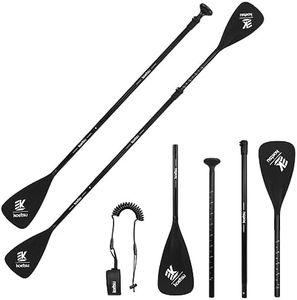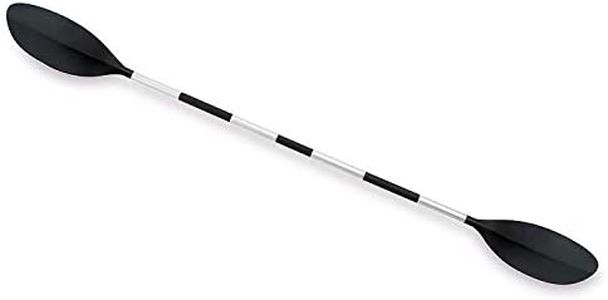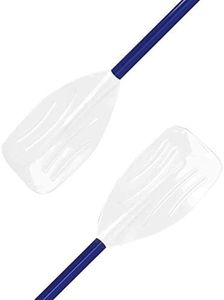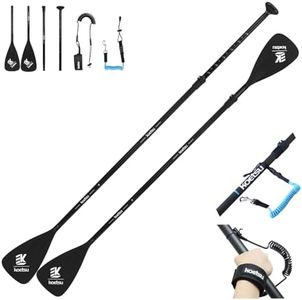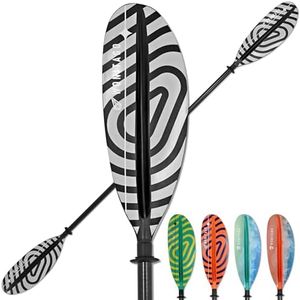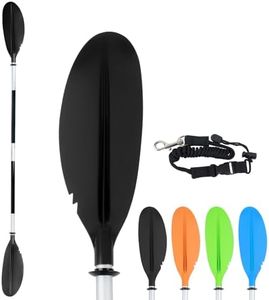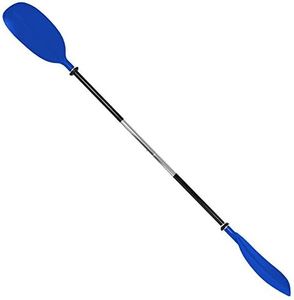We Use CookiesWe use cookies to enhance the security, performance,
functionality and for analytical and promotional activities. By continuing to browse this site you
are agreeing to our privacy policy
10 Best Fishing Kayak Paddles
From leading brands and best sellers available on the web.Buying Guide for the Best Fishing Kayak Paddles
Choosing the right fishing kayak paddle can make your trips more comfortable and efficient. The paddle can impact your speed, comfort, and overall enjoyment while on the water. Each angler has different needs, so it's important to understand the key features and how they relate to your body, kayak, and style of fishing.Paddle LengthPaddle length refers to the total distance from one end of the blade to the other. It's a critical factor because it affects how easily you can reach the water and how efficient your strokes are. The right length typically depends on your height and the width of your kayak. Shorter paddles are lighter and may suit narrower kayaks or shorter paddlers, but they can cause you to bump your hands on the kayak's sides. Longer paddles are better for wider kayaks or taller paddlers, but may feel heavier or cause fatigue over time. When picking a length, consider your body size and kayak width; try a few lengths if possible to see what feels natural.
Blade Shape and SizeThe shape and size of the paddle blades influence how much power you get from each stroke and how easy it is to maneuver the kayak. Wider, larger blades move more water and offer powerful strokes, which is great if you need speed or like to paddle quickly, but can be tiring over long periods. Narrower or smaller blades are easier to use for long distances and are often preferred for a relaxed pacing, especially when fishing. Your choice should be guided by your paddling style—go for larger blades if you value power, or smaller blades if you prioritize endurance and less strain.
WeightPaddle weight is simply how heavy the paddle feels in your hands. Lighter paddles are easier on your arms and shoulders, making them ideal for longer fishing trips or frequent paddling. Heavier paddles are usually more affordable or made of robust materials, but they can tire you out more quickly. If you plan on spending a lot of time on the water or covering longer distances, a lighter paddle can make a big difference in comfort and reduce fatigue.
Shaft MaterialShaft material refers to what the main stick part of the paddle is made from. Common materials include aluminum, fiberglass, and carbon fiber. Aluminum shafts are durable and affordable but heavier, which can make long sessions harder on your arms. Fiberglass shafts strike a balance between weight and strength, offering a mid-range option in terms of comfort and cost. Carbon fiber shafts are very light and comfortable, making them a great choice for avid paddlers, though they tend to be more expensive. Choose based on how much comfort and performance you want versus the increased cost.
Blade MaterialThe blade material affects the paddle's weight, durability, and performance. Plastics and nylon are common and provide durability at a lower cost, but tend to be heavier and less efficient in the water. Fiberglass and carbon fiber blades are lighter and can make paddling feel smoother and more responsive, which is especially welcomed on longer trips. Your pick should depend on how often and intensely you plan to use the paddle—a casual angler might do well with plastic, while frequent kayakers may prefer a lighter, higher-performance material.
Shaft Shape (Straight vs. Bent)Shaft shape describes whether the shaft is straight or has a bend at the grip area. Straight shafts are traditional and work well for most users, providing simple handling and reliable performance. Bent shafts are angled to promote a more ergonomic wrist position, which can help reduce fatigue or the chance of injury over long periods. If you have wrist issues or plan to paddle for extended periods, a bent shaft may be more comfortable, but most users will find a straight shaft perfectly usable.
Adjustability/Breakdown DesignSome paddles can be taken apart into two or more pieces for easy transport and storage (known as breakdown paddles), and some have adjustable lengths. Adjustability is especially helpful if you're not sure what length you need or if multiple people will use the paddle. Breakdown designs are great for anglers who need to save space or travel with their kayak. Think about how you'll transport and store your paddle, and whether sharing with others is likely, before choosing.



